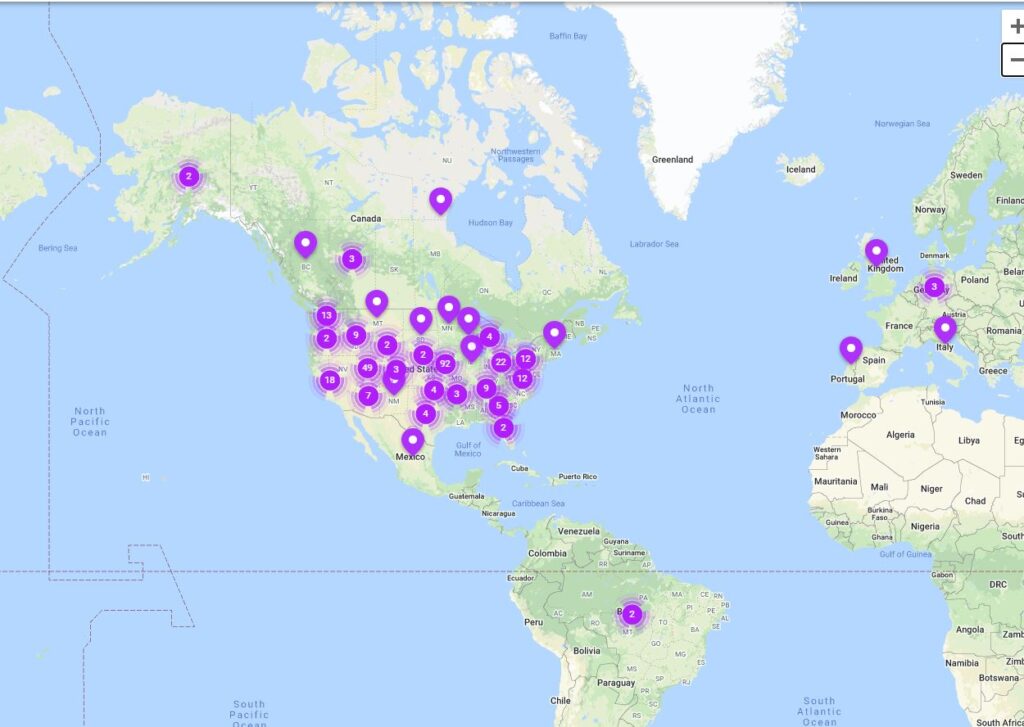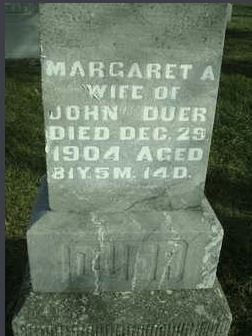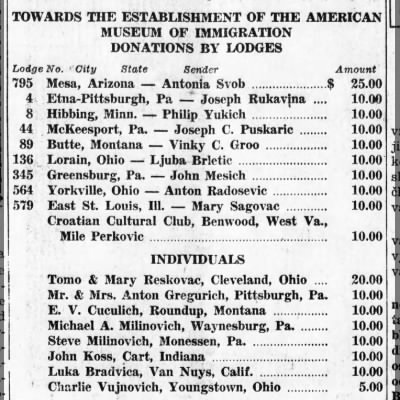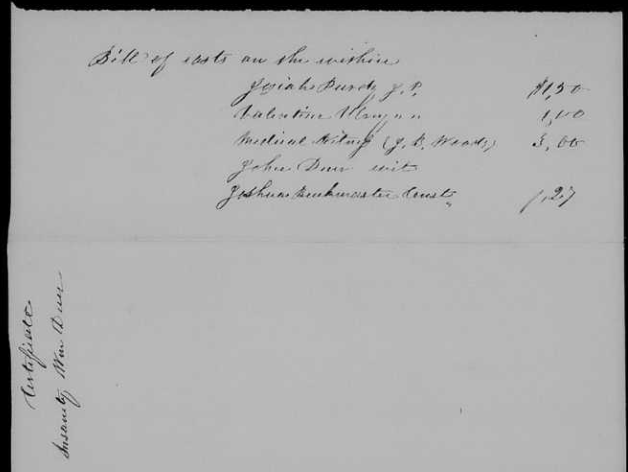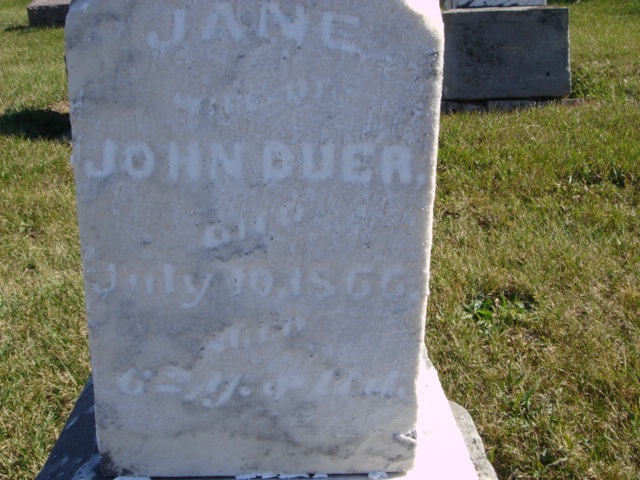
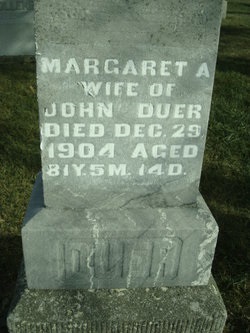
Why was Jane Morrison Duer divorced from her husband John after about 37 years of marriage and eleven children together? Jane followed John from her native Trumbull County, Ohio to Killbuck Township, Holmes, Ohio and on to Mercer County, Ohio over their long years together. What would cause the relationship to end? I have a working hypothesis but no proof. This was a family most likely stressed by societal and personal crises.
Of the 11 children, 5 predeceased Jane. The couple’s first child, a female, died between 1830-1840. We only know of her existence from the 1830 census record’s tick mark that she was in the age group as being “under 5.” No grave has been discovered for her so she remains nameless.
The next child, William, was certified as insane at age 23 in Holmes County and sent to the Ohio Lunatic Asylum. There are only two other records found for William. In the first, he was listed in the 1860 U.S. Federal Census as an insane laborer, age 30, residing in the asylum in Columbus, Franklin, Ohio. That is correct but his birth in Germany is not. That’s interesting to note as his sister and several siblings did marry into the Kuhn family that were immigrants from Germany. Maria, William’s oldest surviving sister, had her birth place listed in error as Germany on her death record provided by her son. William and Maria most likely were born in Trumbull County, Ohio before the family relocated to Holmes County in the late 1930’s.
The second document is a notice in the newspaper, the Holmes County Farmer, on 14 March 1861 recommending that community members write to him and the 7 other “inmates.” I infer he must have been the longest committed as his name appears first. Although alphabetically his surname would be recorded first the others listed are not in alpha order. The article states that “some of these poor unfortunates are supposed to be incurable.” Most of his family had moved on to Mercer County, Ohio by the time the clip was published. No death date has ever been found for William so I suspect he died at the asylum. I am waiting for the organization that holds the records to reopen as they are closed due to the pandemic.
Next oldest son, Thomas Ayers, relocated to Winterset, Madison, Iowa by 1860, enlisted in the Civil War and died unmarried and likely childless of Febris Typhoides on 5 May 1862 in Cincinnati, Ohio.
Daughter Maria wed Henry Kuhn and the couple lived two residences away from Jane and John in 1860. Henry enlisted in the Civil war, leaving Maria to raise their young children. During this time period, John and Jane divorced. Although no record has been found, John remarried in 1864, two years prior to Jane’s death. John relocated with his second wife to Adams County, Indiana where he had two deeds for land. Neither deed had then wife Jane’s name on them. When John died, Maria is not named in his will. Maria’s death certificate names both of her parents.
Son John B. had married first in 1860 but his wife Keziah died a few months after the marriage. He then married Carolina, one of the sibling of Maria’s husband, in 1863 and moved across the state line to farm in Adams County, Indiana. He seems to have had a falling out with his father as like Maria, he is not named in John’s will, even though he was residing in the same county as his father. Marriage records found do not name John B.’s parents. No death certificate for him as been located.
Mary Ann was found living with John and his second wife in 1870, however, she also was not named in his will. She may have had a falling out with her sister Maria as shortly after mother Jane’s death in July 1866, Mary Ann took Adam Kuhn, Maria’s brother-in-law, to court in Mercer County. Pregnant with Adam’s child, the unmarried couple could not agree on a financial settlement. Adam, in December 1866, was jailed by Jacob Baker, who married my 3rd great aunt, Caroline Bollenbacher, as Adam refused surety.
Sister Maria and her husband Henry was close to Adam as evidenced by their naming their son, born in February 1866, after him.
Mary Ann and Adam’s child must not have survived as there is no further court records of payment. He married an Elizabeth or Catharin Harper in Van Wert, Ohio 16 January 1868 and went on to have 5 daughters before dying at age 44, possibly due to injuries sustained during the Civil War when he fought in Union Company F, 99th Ohio Infantry.
Mary Ann married first, James Furman in 1875 who must have died shortly after the marriage as she married second John L. Ceraldo in 1879. John’s first wife had probably died as the child, Daniel, shown living with Mary Ann and John in 1880 would have been too old to have been theirs together. No record is ever found again of the boy who is presumed to have died. Mary died in 1909 in Michigan; her husband named John Duer as her father but her mother’s name was unknown. Although she had married after Jane’s death, why would she have not informed her husband in their 30 years of marriage what her mother’s name had been? Like Maria and John B., Mary Ann was not named in her father’s will.
Son Prosser remained in Holmes County, Ohio after the rest of the family relocated to Mercer County. He enlisted in the Civil War and died at Stones River, Tennessee on 2 January 1863. He did not marry or have any known children.
Daughter Sarah Jane married another sibling of Maria’s husband, Phillip, in 1870, four years after Jane had died. Sarah was also not named in her father’s will. Although she died in 1920, no death certificate or obituary has been found for her.
Son Mark Duer disappears from records after being found in 1850 with the family in Holmes, Ohio. He likely died there but no burial location has been found.
Son James William was found living with John and his second wife in Adams, Indiana in 1870 yet he, too, was not named in John’s will. When James wed in 1887 he named his mother as Sarah J. Marisum sic Morrison. James would have been 18 years old when his mother Mary J[ane] died. How did he not remember her name? Perhaps because she was called by her middle name and he thought of his sister Sarah and not Mary as having the first name as his mother. He spent the rest of his life living in Adams County where he was killed in a bike accident. He death certificate names his father as John but the mother was listed as unknown. It was completed by his son, Elra Leroy. Elra was born 6 years after his grandfather John had died. How did he remember John’s name but not the name of his grandmother Jane?
Youngest child, Angeline, was named in her father’s will. She is the only child of John and Jane’s to be named. She was living with him and his second wife in 1870. She married in 1874 and remained in Adams, Indiana until her death in 1933. Like her siblings, her father John is named on her death certificate. Her mother is recorded as Catharine, born in Ohio. The information was provided by Angeline’s daughter, Effie. Effie probably remembered her grandfather as she would have been 9 years old and living in the same area as him when he died. Where Effie came up with her grandmother’s name as Catherine is unknown as there is no Catherines in the family; her paternal grandmother’s name was Nancy.
Jane is buried in Kessler Cemetery and according to the trustees, the records are incomplete. They do not show who purchased the plot or if her husband John is buried next to her as family lore claims. There is a sunken area that appears to be burial next to Jane but records do not exist to state who is interred there. There is no tombstone. John’s second wife was buried in Kessler but in a different location. John is not buried on either side of his second wife. What is obvious is Jane’s tombstone that is boldly engraved “wife of John Duer” even though she wasn’t at the time of her death.
I suspect daughter Maria purchased the headstone as she was the only child still residing in Mercer County at the time of Jane’s death that had the means to afford it. Maria’s husband was a prosperous farmer and active in the community. In my opinion, Maria wanted the legitimacy of the first marriage noted for eternity.
It’s likely that Margaret’s children paid for her tombstone and wanted to show the world they, too, were legitimate so also engraved their mother as the wife of John.
The year 1866 must have been a tremendously difficult time for Maria. She had 5 children age 7 and under, her parents had recently divorced, her father remarried, her husband was away fighting for the Union in the Civil War, she has a brother that was committed to an insane asylum, 5 deceased siblings and her sister files a bastardly charge against her brother-in-law. What a mess!
But my underlying question is why did Jane and John’s children not hand down their mother’s name to their spouses/children?
Perhaps the state of the union, along with the loss of so many children caused Jane to suffer from the same melancholy as her son, William. John may have abandoned Jane for a new relationship with the widow who owned property close to his newly purchased land across the state lines in Indiana.
I believe Jane was forgotten by her adult children because it was too painful to remember those difficult times. They did not want to inform their children of their mother’s and brother’s mental state. No family member I have reached out to was aware of Williams insanity commitment. The family just didn’t speak about painful situations.
Last week I received a call from a clerk with the Mercer Ohio Common Plea Court. She had searched for a divorce record for John and Jane between 1860 and 1866. None was found. Perhaps John abandoned Jane and the paperwork was filed in Adams County, Indiana where I’ll be searching next. It’s possible that single document may help me better understand the straw that was the backbreaker of the relationship. The search continues!




